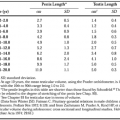MORPHOLOGY AND INNERVATION
Part of “CHAPTER 10 – PINEAL GLAND“
GROSS ANATOMY
The pineal gland, so called because of its resemblance to a pine cone (Latin pineas), is a multifaceted endocrine organ whose secretory products directly or indirectly affect every organ and cell in the body. Embryologically, it is derived from neuroectoderm as an outgrowth of the diencephalon. In adults, it is attached to the posterodorsal aspect of the diencephalon, and its proximal portion is invaginated by the pineal recess of the third ventricle (Fig. 10-1). The gland weighs ˜130 mg, with great individual variation seen, and is ˜1 cm long. The blood supply to the gland is derived from the posterior choroidal branches of the posterior cerebral arteries. The pineal gland has a copious blood supply. In advanced age, it may acquire calcium deposits (corpora arenacea, acervuli), which are visible on skull radiographs.
Stay updated, free articles. Join our Telegram channel

Full access? Get Clinical Tree







